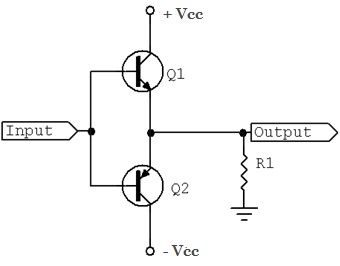An electronic circuit in which two transistors (or vacuum tubes) are used, one as a source of current and one as a sink, to amplify a signal. One device “pushes’’ current out into the load, while the other “pulls” current fromit when necessary. A common example is the complementary-symmetry push-pull output stage widely used to drive loudspeakers (see illustration), where an NPN transistor can source (push) current from a positive power supply into the load, or a PNP transistor can sink (pull) it into the negative power supply. The circuit functions as an amplifier in that the current levels at the output are larger than those at the input.

A so-called bias network in a complementary-symmetry push-pull output stage (see illustration) functions to maintain a constant voltage difference between the bases of the two transistors. It can be designed either by setting a bias current and diode sizes or by replacing it with a different network for class B, class A, or the common compromise, class AB mode of operation. In class B operation, where the bases of the transistors might simply be shorted together, only one transistor is “on’’ at a time and each is on average “on” for only 50% of the time; when the output current is zero, no current at all flows in the circuit. In class A operation a large voltage is maintained between the bases so that both devices stay “on’’ at all times, although their currents vary so that the difference flows into the load; and even when the output is zero, a large quiescent current flows from the power supplies. Class B operation is much more efficient than class A, which wastes a large amount of power when the signal is small. However, class B suffers from zero-crossing distortion as the output current passes through zero, because there is generally a delay involved as the input swings far enough to turn one transistor entirely off and then turn the other on. In class AB operation, some intermediate quiescent current is chosen to compromise between power and distortion.







